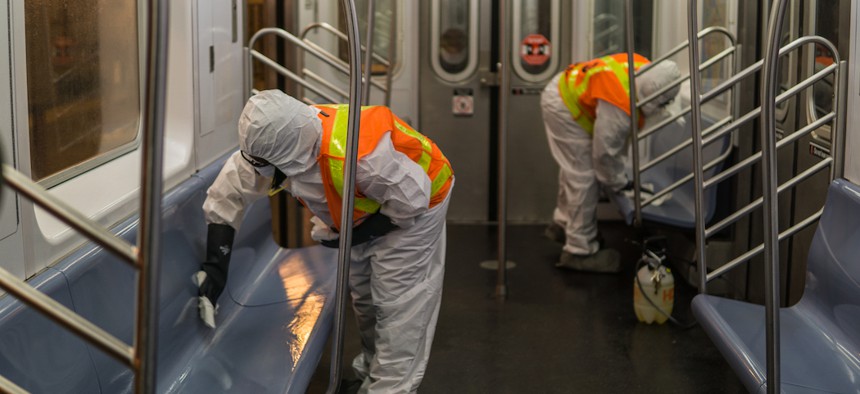On May 1, thousands of tenants across the state launched a rent strike, demanding relief with so many unable to pay amid the coronavirus crisis. About a week later, it seems that Gov. Andrew Cuomo heard them … sort of. After weeks of insisting that his 90-day eviction moratorium resolved the issue, Cuomo announced some new relief measures, extending the moratorium until Aug. 20 and saying that New Yorkers could use their security deposit to pay rent. He also eliminated late payment fees for rent during the period. It’s a far cry from the total rent cancellation that tenant advocates want, but it’s still more than Cuomo had done before. Keep reading for the rest of this week’s news.
Overnight subway suspension begins
For the first time in over 100 years, the Metropolitan Transportation Authority suspended 24-hour subway service, shutting it down from 1 a.m. to 5 a.m. every night for the foreseeable future to clean and disinfect trains. MTA Chairman and CEO Pat Foye said Gov. Andrew Cuomo would decide when full service would return, and Cuomo gave no indication when that might be other than after the pandemic ends. An estimated 11,000 straphangers per night, largely essential workers, are expected to be impacted. On the first night of suspended service, New York City Transit Interim President Sarah Feinberg said that 2,000 homeless New Yorkers were removed from the subway, although the city said only 252 had contact with city outreach workers, and 139 accepted aid. Many wound up on the streets, or simply shifted to buses. The night was also plagued with problems. At one station, private workers hired by the MTA did not receive adequate personal protective equipment and six walked out partway through the night. Some riders hadn’t known about the closure until members of the news media told them when asking for reactions.
The phases of reopening
Cuomo provided more details about how regions of the state can begin to reopen. He broke down the process into four phases, with different industries reopening in each based on the risk involved and necessity of the service. The first phase will include construction, manufacturing and some curbside pickup retail. Provided there is no sign of a resurgence of new COVID-19 cases, the region can move on to the next phases, reopening retail stores fully, professional services, restaurants and hotels. The final phase would bring the return of arts, entertainment and education. The statewide stay-at-home order is in effect until May 15, and although Cuomo indicated parts of the state might begin reopening around then, he said that no regions are ready yet. The governor laid out seven criteria a region would need to meet before reopening, including 14 straight days of death and hospitalization declines, 30 contract tracers per 1,000 residents and keeping 30% of hospital beds open. Some upstate leaders expressed concern that they wouldn’t be able to meet certain requirements, like hiring the number of contact tracers Cuomo required.
Racial disparities in social distance policing
Police in New York City have begun enforcing social distancing as more people are spending time outside in the warmer weather. But it’s not happening equitably. A viral video showed a violent confrontation with a non-white bystander while an officer attempted to make a social distancing arrest. The same weekend, photos showed mostly white New Yorkers crowded Manhattan parks with nary a cop in sight. According to The New York Times, of 40 people arrested for failing to socially distance between March 17 and May 4 in Brooklyn, 35 were black, four were Hispanic and only one was white. Even Brooklyn Borough President Eric Adams, a former police officer and supporter of the NYPD, thought that social distancing enforcement would exacerbate tensions between police and minority communities.
New York will have a presidential primary, after all
The cancellation of the state’s June 23 Democratic presidential primary only lasted about one week. After U.S. Sen. Bernie Sanders suspended his campaign, the Democratic co-chair and commissioner of the state Board of Elections had removed him and every other candidate who had dropped out from the ballot, leaving only Joe Biden. The Board of Elections decided that holding a moot contest would just risk lives during a pandemic. However, former presidential candidate Andrew Yang, joined by delegates for Sanders, sued to bring the race back. And a federal judge sided with them, ruling that since that state expanded absentee voting for the many other primary elections happening the same day, safety concerns did not warrant canceling the contest. The state Board of Elections has already appealed the decision, meaning that it may be reversed again.
Seawright proven right
And to think, Manhattan almost elected a Republican. Assemblywoman Rebecca Seawright, a Democrat, had failed to make the ballot this year in her run for reelection because she turned in crucial paperwork late. That meant the Republican candidate, doorman Louis Puliafito, likely would have been the newest Manhattan Assembly member, since he wasn’t going to face any other opponents on the ballot. But Seawright sued the New York City Board of Elections, saying the standards should be different because of the coronavirus, and a judge on Friday agreed with her. Seawright will be back on the ballot, and all but guaranteed another victory in November. Her ongoing headache isn’t over yet though – Puliafito has vowed to appeal.
– Jeff Coltin contributed reporting


